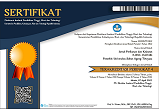Identification of Antibiotic-Producing Bacteria from Extreme Microhabitat in Molecular Mangrove Ecosystems and Their Activity on Pathogenic Bacteria (Vibrio alginolyticus)
Abstract
Keywords
Full Text:
PDFReferences
Adithiya DS, Feliatra F, Afrizal T. 2017. Using of Bacteria Heterotrophic as an Anti-Bacterial Againts Pathogenic Bacteria Isolated from Sea Water in Dumai City , Riau Province. Jurnal Online Mahasiswa Fakultas Perikanan dan Kelautan Universitas Riau 4(2) : 1-17.
Auta HS, Emenike CU, Fauziah SH. 2017. Screening of Bacillus Strains Isolated from Mangrove Ecosystems in Peninsular Malaysia for Microplastic Degradation. Jurnal Environmental Pollution 231: 1552 (Abstr.). Environmental Pollution : DOI 10.1016/j.envpol.2017.09.043.
Bennett LR, Budi W, Auky H, Adnyana IBP, Mulyoto P. 2012. Indonesian infertility patients’ health seeking behaviour and patterns of access to biomedical infertility care: an interviewer administered survey conducted in three clinics. Jurnal Reproductive Health 9(24): 1-7 http://www.reproductive-health-journal.com/content/9/1/24.
Borong, MF. 2012. Kerasionalan Penggunaan Antibiotik Pada Pasien RawatInap Anak Rumah Sakit M.M Dunda Limboto Tahun 2011. [Skripsi]. Gorontalo : Program Studi D-III Farmasi Fakultas Ilmu-ilmu Kesehatan dan Keolahragaan Universitas Negeri Gorontalo.
Brooks GT, Butel JS, Morse SA, Jawetz E, Melnick JL, Adelberg EA. 2004. Medical Microbiology 23rd edition. Mc Graw Hill Companies Inc.
Elifah. E. 2010. Uji Antibakteri Fraksi Aktif Ekstrak Metanol Daun Senggani (Melastoma candidum, D. Don) Terhadap Escherichia coli dan Bacilus subtilis Serta Profil Kromatografi Lapis Tipisnya. [Skripsi]. Surakarta: UNS.
Feliatra F, Fitria Y, Nursyirwani N. 2012. Antagonis bakteri probiotik yang diisolasi dari usus dan lambung ikan kerapu bebek (Cromileptes altivelis) terhadap bakteri patogen. Jurnal Perikanan dan Kelautan 17(1) : 16 – 25.
Fluit ADC, Visser MR, Schmitz FJ. 2001. Molecular Detection of Antimicrobial Resistance. Clinical Microbiology Reviews 14(4):836-71.
Gangadharan D, Sivaramakrishnan S, Nampoothiri KM, Pandey A. 2006. Solid Culturing of Bacillus amyloliquefaciens for Alpha Amylase Production. Jurnal Biotechnol 44(2) : 269–274.
Gilmore MS, Coburn PS, Nallapareddy SR, Murray BE. 2002. Enterococcal Virulence. In M. S. Gilmore, D. B. Clewell, P. Courvalin,G.M. Dunny, B. E. Murray, and L.B. Rice (Eds). The Enterococci: Pathogenesis Molecular Biology, and Antibiotic Resistance. Asm Press. Washington, DC. 301-354. ISBN: 1-55581-234-1
Hagstrom, Pinhassi AJF, Zweiefel UL. 2000. Biogeoghraphycal Marine DiversityAmong Bacretioplankton. Aquatic Microbial Technology 21: 231-244.
Holderman MV, Queljoe ED, Rondonuwu SB. 2017. Identifikasi Bakteri Pada Pegangan Eskalator di Salah Satu Pusat Perbelanjaan di Kota Manado. Jurnal Ilmiah Sains 17(1): 1-6.
Krismawati H, Sembiring L, Wahyuono S. 2015. Streptomycetes Penghasil Antibiotik yang Berasosiasi dengan rhizosfer beberapa Spesies Mangrove. Jurnal PLASMA 1(2): 59-70.
Nguyen DV, Pham T, Nguyen TH, Nguyen TT. 2014. Screening of Marine Bacteria with Bacteriocin like Activities and Probiotic Potential for Ornate SpinyL obster (Panulirus ornatus) Juveniles. Journal Fish Shell Immun 40(1) : 49-60.
Noaman NH, Fattah A, Khaleata M, Zaky SH. 2004. Factor Affecting Antimicrob Activity of Synechococus leopoliensis. Journal Microbiol Research 159(4): 395-402.
Rola AC, Narvaez TA, Naguit MRA, Elazegui DD, Brillo BBC, Paunlagui MM, Jalotjot HC, Cervantes CP. 2018. Impact of the closed fishing season policy for sardines in Zamboanga Peninsula, Philippines. Marine Policy (87): 40–50. DOI: 10.1016/j.marpol.2017.09.029.
Romanengko LA, Naoto T, Masataka U, Natalia IK, Valery VM. 2008. Diversity and antagonistic activity of sea ice bacteria isolated from the sea of Japan. Microbiol Environ 2(3): 209-214.
Romero J, Feijoó CG, Navarrete P. 2012. Antibiotics in aquaculture – use, Abuse and Alternatives. Chile : Universidad de Chile, Biotechnology Laboratory (INTA) Sara Savic. 43 hlm.
Sahoo TK, Jena PK, Patel AK, Seshadri S. 2014. Bacteriocin and their Application for The Treatment of Bacterial Diseases in Aquaculture : Journal Aquacult Research 47(4) : 1013-1027.
Sari YNM. 2013. Isolasi, Karakterisasi dan Identifikasi DNA Bakteri Asam Laktat ( BAL) yang Berpotensi Sebagai Antimikroba dari Fermentasi Markisa Kuning (Passiflora edulis var.flavicarfa) [Skripsi]. Padang: Diploma Thesis, Universitas Andalas
Singleton P dan Sainbury D. 2001. Dictionary of Microbiology and Molecular Biologi, 3rd Edition.
Susana M. 2017. Isolasi dan Karakterisasi Bakteri Heterotrofik pada Perairan Laut Kawasan Pemukiman dan Perairan Bersalinitas Rendah di Kelurahan Purnama Dumai Provinsi [Skripsi]. Pekanbaru: Universitas Riau.
The European Commission. 2010. Commission Regulation (EU) No37/2010 of 22 December 2009 on pharmacologically active substances andtheir classification regarding maximum residue limits in foodstuffs of animal origin. Official Journal of the European Union 15(2377): 1–72. http://doi.org/2004R0726 - v.7 of 05.06.2013.
Umoro A. 2016. Isolasi Bacillus Sp. Penghasil Bakteriosin dan Peningkatan Aktivitasnya sebagai Penghambat Vibrio harveyi [Tesis]. Bogor: Sekolah Pascasarjana Institut Pertanian Bogor.
Utami ER. 2011. Antibiotika, resistensi, dan rasionalitas terapi. Jurnal SAINSTIS 1(1): 191–198.
Utami RA. 2011. Aktivitas Antibakteri Ekstrak Alkaloid Ageratum conyzoides L Terhadap Pertumbuhan Bakteri Staphylococcus aureus Secara In Vitro. [Skripsi]. Bandung: Jurusan Pendidikan Biologi FMIPA UPI Bandung
Vazquez DE, Duarte CM, Agusti S, Jurgen K, Vangue D, Gasol JM. 2008. Microbial plankton abundance and heterotrophic activity across the central Atlantic Ocean. Journal Progress in Oceanography 79(1): 8394.
Větrovský T, Baldrian P. 2013. The Variability of the 16S rRNA Gene in Bacterial Genomes and Its Consequences for Bacterial Community Analyses. Journal PloS ONE 8(2) : 1-10.
Wijayanto N, Feliatra, Nedi S. 2015. Antagonism Test Of Probiotics Bacteria Isolated From Black Tiger Shrimp (Penaeus monodon) Against Pathogens (Aeromonas hydrophila, Pseudomonas sp and Vibrio alginolyticus). Jurnal Online Mahasiswa Fakultas Perikanan dan Kelautan Universitas Riau 2(1): 1-8.
DOI: http://dx.doi.org/10.33512/jpk.v9i2.8628
Refbacks
- There are currently no refbacks.



_-_Copy1.png)